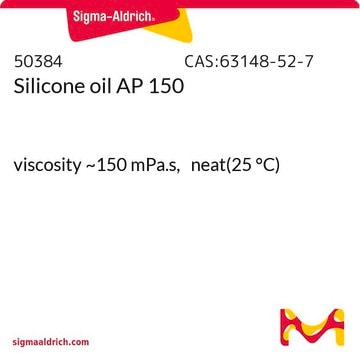85409
Silicone oil
for oil baths (from −50°C to +200°C)
Sinonimo/i:
Dimethyl polysiloxane
Autenticatiper visualizzare i prezzi riservati alla tua organizzazione & contrattuali
About This Item
Formula condensata:
[-Si(CH3)2O-]n
Numero CAS:
Numero MDL:
Codice UNSPSC:
12352100
NACRES:
NA.21
Prodotti consigliati
Grado
for oil baths (from −50°C to +200°C)
Livello qualitativo
Densità del vapore
>1 (vs air)
Tensione di vapore
<5 mmHg ( 25 °C)
5 mmHg ( 20 °C)
Forma fisica
oil
Indice di rifrazione
n20/D 1.403 (lit.)
n20/D 1.406
Viscosità
100 mPa.s(20 °C)
P. eboll.
>140 °C/0.002 mmHg (lit.)
Densità
0.967 g/mL at 20 °C
Cerchi prodotti simili? Visita Guida al confronto tra prodotti
Descrizione generale
Silicone oil is typically used for oil baths in research labs for reactions that require heating/reflux temperatures in the range of -50°C to +200°C. Oil baths provide more uniform heat in comparison to other heating devices.
Silicone oil is useful for the preparation of oil baths having a temperature in the range of -50°C to +200°C.
Applicazioni
Silicone oil has been used for the protection of carbon steel alloy samples in a study. Silicone oil has also been used as a heat reservoir during NMR (Nuclear Magnetic Resonance) analysis.
Codice della classe di stoccaggio
10 - Combustible liquids
Classe di pericolosità dell'acqua (WGK)
WGK 1
Punto d’infiammabilità (°F)
214.0 °F - closed cup
Punto d’infiammabilità (°C)
101.1 °C - closed cup
Dispositivi di protezione individuale
Eyeshields, Gloves
Choose from one of the most recent versions:
Possiedi già questo prodotto?
I documenti relativi ai prodotti acquistati recentemente sono disponibili nell’Archivio dei documenti.
I clienti hanno visto anche
Low-temperature atomic layer deposition of Al2O3 thin coatings for corrosion protection of steel: surface and electrochemical analysis.
Diaz B, et al.
Corrosion Science, 53(6), 2168-2175 (2011)
M Findeisen et al.
Magnetic resonance in chemistry : MRC, 45(2), 175-178 (2006-12-13)
Most established NMR thermometers rely on temperature-dependent chemical shift differences measured from samples that are either neat or concentrated solutions (e.g. ethylene glycol, methanol). These are unsuitable for modern cryoprobes on account of strong radiation damping resulting from the high
Zhiyong Li et al.
Optics express, 21(1), 1281-1286 (2013-02-08)
A gold nanorod-facilitated optical heating method for droplets in microfluidic chips is reported. Individual and stream nanoliter level droplets containing gold nanorods are heated by a low power 808-nm-wavelength laser. Owing to the high photothermal conversion efficiency of gold nanorods
Amir Sanati Nezhad et al.
Proceedings of the National Academy of Sciences of the United States of America, 110(20), 8093-8098 (2013-05-01)
Tip-growing cells have the unique property of invading living tissues and abiotic growth matrices. To do so, they exert significant penetrative forces. In plant and fungal cells, these forces are generated by the hydrostatic turgor pressure. Using the TipChip, a
Dennis C van Duijvenbode et al.
Foot and ankle surgery : official journal of the European Society of Foot and Ankle Surgeons, 19(1), 27-30 (2013-01-23)
The purpose of this retrospective study is to evaluate patient-related outcome and reoperation rate of the Swanson prosthesis in patients with and without grommets. Between 1981 and 1999, 98 Swanson MTP-1 prostheses were implanted in 84 patients (14 bilateral). The
Il team dei nostri ricercatori vanta grande esperienza in tutte le aree della ricerca quali Life Science, scienza dei materiali, sintesi chimica, cromatografia, discipline analitiche, ecc..
Contatta l'Assistenza Tecnica.



